Diabetes affects millions worldwide, and managing this chronic condition can often feel like a never-ending puzzle.
However, in our increasingly digital age, new tools and technologies are emerging to transform how we approach diabetes care.
At the forefront of this revolution is artificial intelligence (AI), a game-changing force that promises to enhance daily life for individuals with diabetes.
In this blog post, we'll unravel the potential of AI, examining its role in improving glucose control, providing personalized insights, and even predicting future health outcomes.
Did you know? Your genes hold precious clues about nearly all aspects related to your health and wellness. Harnessing this information can help prevent diseases, improve diet, age gracefully, and maintain a healthy weight. Learn how:
Diabetes is a chronic condition that affects millions of people globally.
It occurs when the body struggles to regulate blood sugar levels, which are critical for our cells' energy production.
The pancreas plays a vital role in this process by producing insulin, a hormone that enables the body to manage glucose levels effectively.
However, insulin production complications can lead to abnormal sugar levels and result in diabetes.
Diabetes is classified into numerous categories. The most widespread are type 1, type 2, and gestational diabetes.
Is Type 2 Diabetes Genetic?
Blood sugar monitoring, dietary adjustments, and, in some cases, insulin therapy are essential in managing gestational diabetes to ensure a healthy pregnancy and delivery.
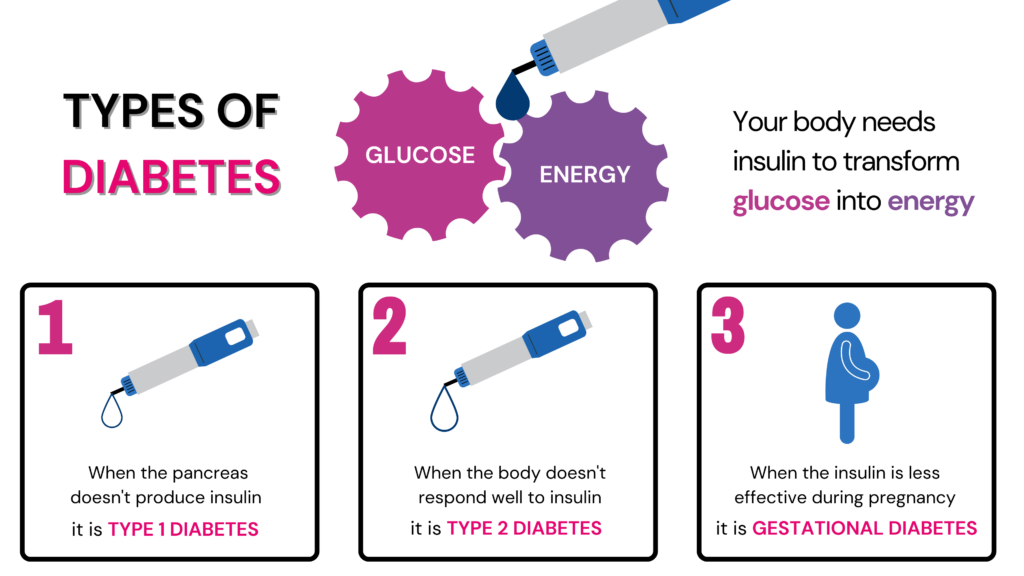
Living with diabetes presents numerous challenges that require continuous management and care. Some of them are:
The ever-evolving progress of AI has revolutionized how diabetes is treated and monitored, introducing numerous possibilities for enhanced care.
Traditional glucose monitoring typically involves periodic finger pricks to measure blood sugar levels.
By using AI technology, monitoring glucose levels has undergone a remarkable transformation.
Continuous glucose monitoring (CGM) devices use tiny skin-implanted sensors to test glucose levels faster than slower traditional methods.
Lots of data are gathered and then examined using machine learning techniques.
The algorithms can detect abnormal events, trends, or patterns in glucose data from this process.
Benefits of AI-driven glucose monitoring
AI can continuously analyze glucose levels and consider factors like carbohydrate intake and activity levels.
It can then use this information to deliver precise and timely insulin doses without requiring manual calculations or frequent user intervention.
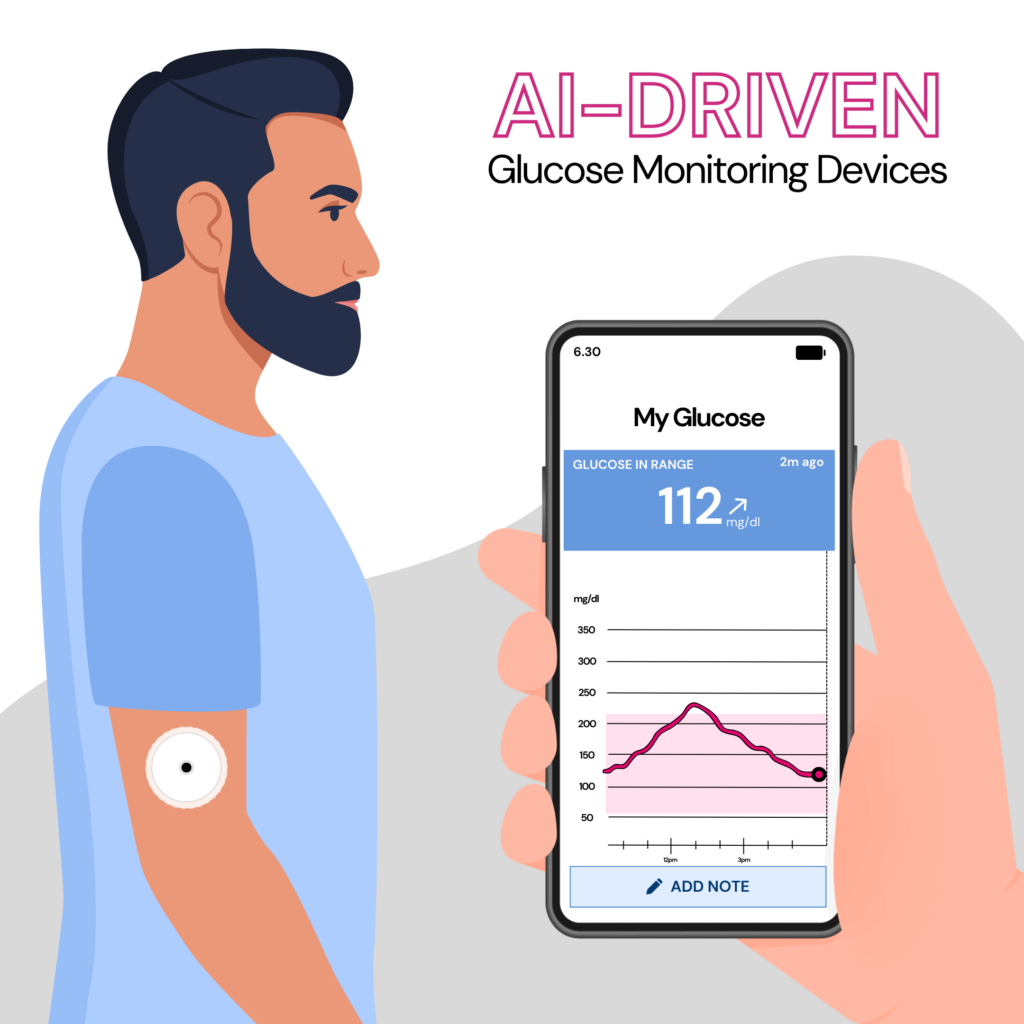
The advantages of AI-powered smart insulin pumps include the following:
It is important to note that AI technologies in diabetes management are meant to support and complement the expertise of healthcare professionals.
While these technologies offer valuable insights and automation, they should always be used under medical supervision and with personalized care plans.

Machine learning techniques have been used in medical health research, including predicting diabetes.
In a study, researchers used AI and machine learning (ML) technologies to predict diabetes in a dataset from a hospital in Luzhou, China.
The three tools used here include:
All these employ AI and ML but use slightly different techniques.
The scientists divided the data into training sets and a test set to test their methods.
They used the training sets to teach the computer program how to make predictions. Then they used the test set to see how accurate the predictions were.
While they used various methods to assess and simplify the data, they found that using all the information about a person's health was the best way to predict diabetes.
Further, while all the 3 tools predicted diabetes accurately, random forest was the best predictor.
This study shows that machine learning can help predict diabetes.
By using these computer programs, doctors can understand who might develop diabetes in the future and take steps to prevent it or manage it better.
Mobile apps are a simple and convenient way to manage diabetes.
Features like glucose level tracking, meal planning, medication reminder, and other insights can prove useful for those with diabetes.
These are some commonly used apps:
Note: The apps in this list are not our recommendations, and we do not vouch for any of them. This is for informational purposes only. The best app for you will depend on your needs.
The following features provided by most diabetes care apps make them useful tools for managing this condition:
Can AI help with a breast cancer diagnosis?
Using AI in diabetes care can help prevent the condition in the following ways:
By harnessing the power of AI, healthcare providers can enhance preventive efforts, enable early detection, and provide personalized care for individuals at risk of developing diabetes.
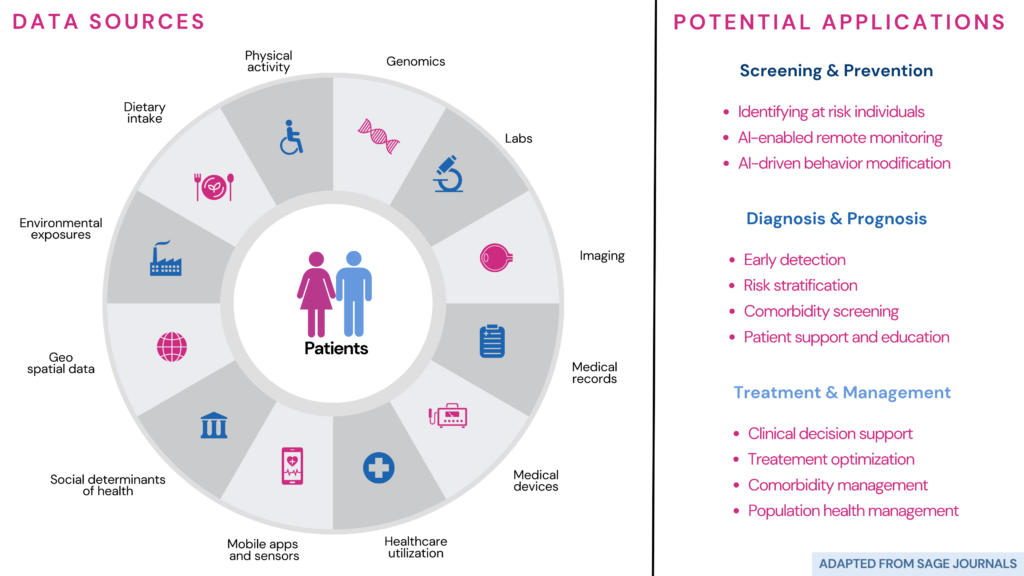
Discussing the ethical issues in AI implementation is important as it continues influencing diabetic care. Developing AI ethically and preserving human control also involves safeguarding data privacy and preventing algorithmic biases.
However, the future possibilities of AI in diabetes management are promising, offering advancements that can revolutionize daily life for individuals with diabetes.
Let's briefly discuss these considerations and their potential effects in the future:
Future Directions
Integrating AI into the lives of those with diabetes has immense potential for transformative change.
The benefits of AI are enormous, from managing diabetes more effectively to improving quality of life and overall health outcomes.
AI-based glucose monitoring technologies, such as CGM systems, offer the following benefits:
Smart insulin pumps powered by AI algorithms provide automated insulin delivery, improving glycemic control and more comfort.
Moreover, AI can predict the risk of developing diabetes by analyzing vast datasets and generating personalized risk assessments.
Diabetes care apps integrated with AI provide on-the-go monitoring, customized support, seamless data integration, reminders, notifications, and community support.
Ethical considerations, such as data privacy, algorithm bias, and human oversight, are crucial when implementing AI in diabetes care.
The advancements in AI for diabetes management have promising future implications.
These include continuous glucose monitoring, closed-loop systems, incorporation with wearable devices, and adopting a comprehensive approach to care.
https://www.healthline.com/health/diabetes/top-iphone-android-apps
https://www.ncbi.nlm.nih.gov/pmc/articles/PMC4422872/
https://www.ncbi.nlm.nih.gov/pmc/articles/PMC7530691/
https://www.ncbi.nlm.nih.gov/pmc/articles/PMC7325854/
https://www.ncbi.nlm.nih.gov/pmc/articles/PMC6859270/
https://www.nature.com/articles/s41591-022-02144-z
https://www.frontiersin.org/articles/10.3389/fsurg.2022.862322/full
https://pubmed.ncbi.nlm.nih.gov/28585879/
https://www.frontiersin.org/articles/10.3389/fgene.2018.00515/full
https://academic.oup.com/edrv/article/44/2/254/6692818
https://www.niddk.nih.gov/health-information/diabetes/overview/what-is-diabetes
https://www.ncbi.nlm.nih.gov/pmc/articles/PMC6550406/
https://my.clevelandclinic.org/health/drugs/11444-glucose-continuous-glucose-monitoring
We humans often experience pain as an unwelcome barrier. But what if there was a way to break through those barriers?
What if physical activity held the key to unlocking a higher pain tolerance? A new study reinforces that engaging in physical activities reduces chronic pain experience.
This article reveals pain tolerance, the factors affecting them, and how physical activity is associated with pain tolerance effect with a study supporting this concept.
Read on to uncover further insights.
Your genes play a strong role in influencing your pain threshold.
Pain tolerance is the capacity of a person to handle or tolerate pain.
Individuals with higher pain tolerance can feel less pain than those with moderate or low pain tolerance.
A simple example is a person's ability to touch a hot surface. A person with higher tolerance can have higher exposure than others.
Some factors influence the pain tolerance of an individual.
Genetics has emerged as a significant factor in understanding the variation in pain tolerance among individuals.
Our genetic makeup plays a crucial role in determining how we perceive and respond to pain stimuli.
Studies have shown that certain genetic variations can affect the functioning of pain receptors, neurotransmitters, and inflammatory pathways, ultimately influencing our pain perception and tolerance levels.
Research strongly suggests that males and females differ in their responses to pain.
This is due to differences in the anatomy, genetic makeup, types and levels of hormones, nerve responses, etc., between males and females.
Each of us possesses a unique lifestyle and varying levels of exposure to different experiences. For instance, people who smoke may be more sensitive to pain.
On the other hand, athletes have a higher pain tolerance.
It’s no secret that your mind and body are connected. So, anything that affects your mental health, including conditions like depression and anxiety, may increase pain sensitivity.
Engaging in physical activities/exercises is associated with higher pain tolerance.
During exercise, the body releases chemical compounds known as endorphins.
Endorphins are the body’s natural pain-relieving chemicals.
They engage with specific parts of the brain, subsequently diminishing one's perception of pain.
This decrease in pain sensation through exercise is termed exercise-induced hypoplasia.
Furthermore, repeated exposure to discomfort during exercise might lead to adaptations in the central nervous system, resulting in enhanced pain tolerance.
However, the exact mechanisms behind this connection are not yet fully understood.
Many aspects of our fitness, like injury risk, endurance potential, lung capacity, tendon strength, and pain tolerance, are influenced by our genes. Learning about how your genes impact fitness can be very helpful in achieving your fitness goals.
According to a recently published study in PLOS ONE, higher levels of physical activity have been found to decrease or prevent chronic pain sensation.
This study was conducted by nine researchers affiliated with the Department of Pain, University Hospital of North Norway, Tromsø, Norway, and some centers in Norway.
The study included 10,732 Norwegian adults, 51% of whom were females.
The participants’ mean age was 55.8 years.
The study measured two parameters: physical activity and pain tolerance.
The former was self-reported by the participants as “leisure-time physical activity,” which includes all physical activities done during the day, including exercise.
Pain tolerance was measured using a cold-pressor test (CPT) where the participants had to submerge their hands (till their wrists) in water (3°C) for as long as possible.
Certain workouts have shown promising results when it comes to improving pain tolerance through exercise. Here are some of the best exercises to consider:
Remember, it's important to listen to your body and start at an appropriate level of intensity that is best for your needs.
Consult a healthcare professional or fitness expert for any underlying health conditions or concerns.
Pain tolerance refers to a person's ability to endure or withstand pain.
Factors like age, gender, genetics, environment, and lifestyle factors might influence a person to experience pain tolerance.
A new study suggests that engaging in physical activity is associated with higher pain tolerance - the more intensity, the higher the pain tolerance.
Certain types of physical activities, like HIIT, resistance training, yoga, and tai-chi, in particular, are known to improve pain tolerance.
Having a drink once in a while is acceptable. However, if you drink frequently and for an extended period, you develop alcohol tolerance.
While most people may boast about their tolerance to alcohol, when unchecked, it can lead to harmful health consequences, including addiction and liver disease.
Several reasons affect your tolerance to alcohol, and no two people will have the same alcohol tolerance.
Let’s explore the various factors of alcohol tolerance and how your genes have a role to play in it!
Tolerance is your body’s ability to suppress normal responses to substances and toxins.
Alcohol tolerance refers to a situation where continuous drinking results in the same amount of alcohol having a lesser effect on the body.
An increased amount of alcohol may be required to produce the same effects.
Your alcohol tolerance depends upon how your body responds to it in different situations, how much remains in the system, and the efficiency in eliminating it.
Someone with a greater tolerance usually enjoys many drinks without feeling “drunk.”
Alcohol tolerance is one of the many prominent symptoms of alcohol dependence.
This is, in fact, a stage of alcohol addiction when you need a drink to prevent alcohol withdrawal symptoms.
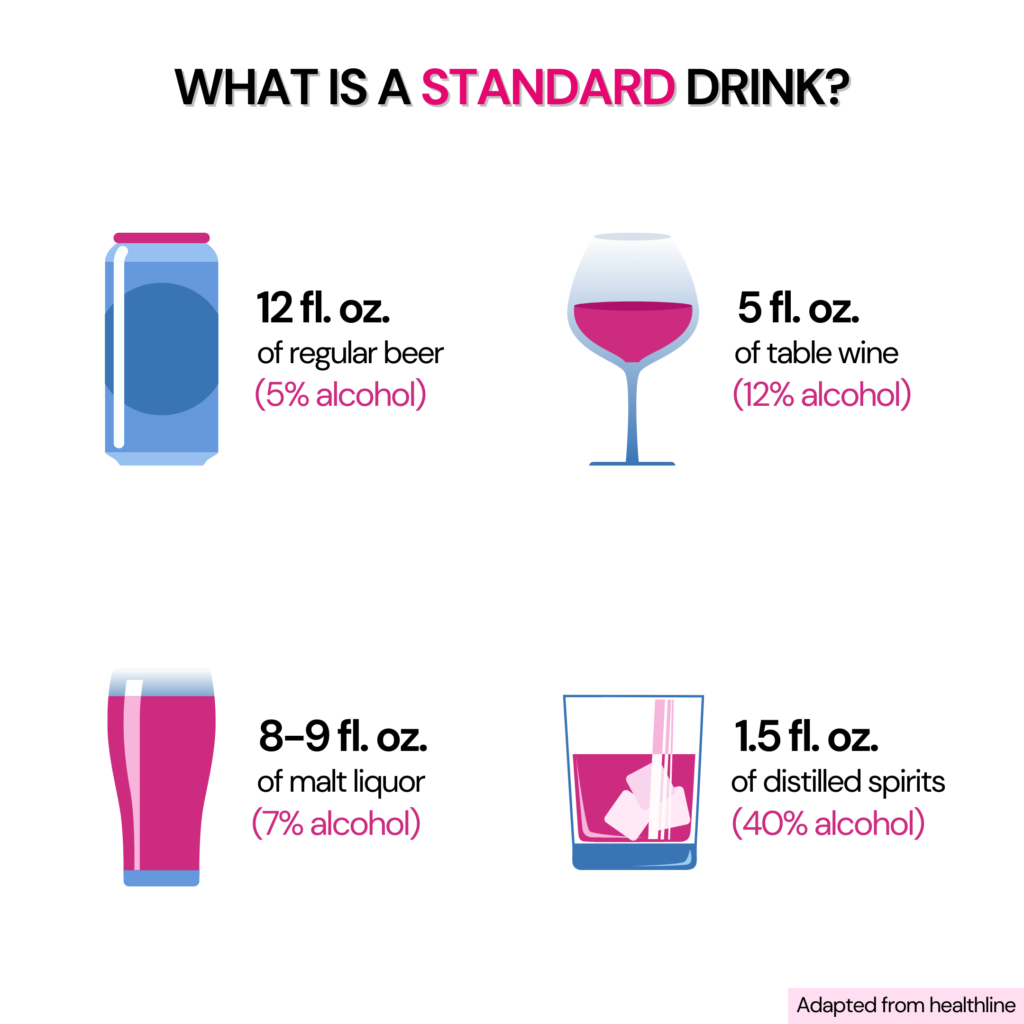
Genetics plays a significant role in alcohol tolerance.
Changes in the genes, including ADH1B and ALDH2, that participate in alcohol metabolism can influence alcohol tolerance in individuals.
How fast or slow your body breaks down or metabolizes alcohol is influenced by your genes.
Studies report that genetics influences 40% to 60% risk of alcohol-related disorders.
Alcohol is broken down or metabolized by 3 main enzymes.
Any differences in these enzymes make people metabolize alcohol differently.
In fact, genetic differences in these enzymes are responsible for why different ethnic groups have higher or lower alcohol-related problems.
Higher levels of ADH enzymes and lower levels of ALDH2 enzymes can result in the build-up of acetaldehyde.
This leads to poor alcohol tolerance.
A type of the ADH gene called the ADH1B*2 (primarily found in Asian and Polynesian populations) produces the ADH1B enzyme with 100-fold activity.
This protects people with this gene variant from alcohol dependence.
The ALDH2 gene produces the ALDH2 enzyme.
A genetic mutation in the ALDH2 gene makes the gene less active or inactive.
A type of this gene called the ALDH2*2 gene has been observed in the Asian population.
This type produces the ALDH2 enzyme with 85% lower activity in the liver and inhibits voluntary consumption of alcohol by 50%.
Here's how you can still get your alcohol dependence report
Alcohol intolerance is a genetic condition in which the body prevents the effective breakdown of alcohol.
While many people do not develop any adverse reaction to consuming alcohol, some people who are alcohol intolerant may show some signs and symptoms.
When these alcohol-intolerant people consume alcohol, they experience an unpleasant phenomenon called a flush reaction.
A few common symptoms of alcohol flush reaction are:
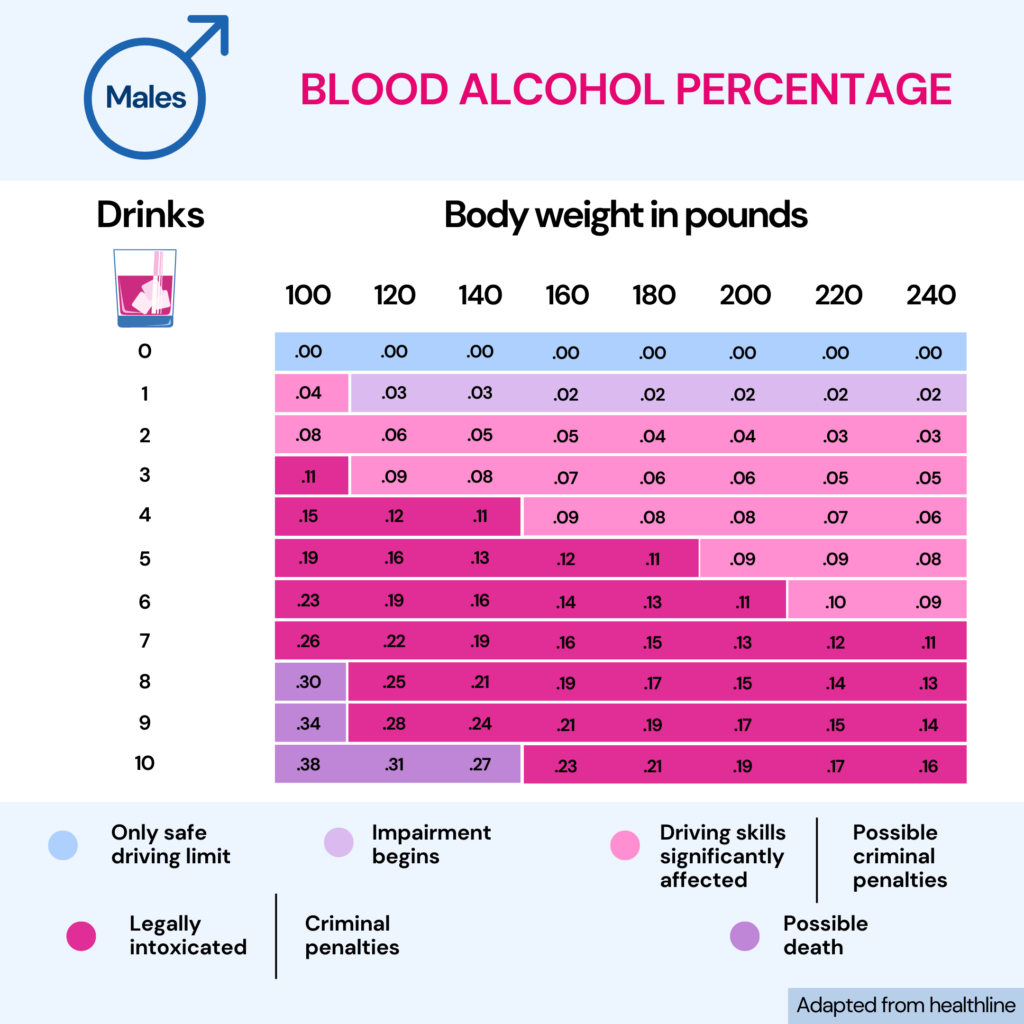
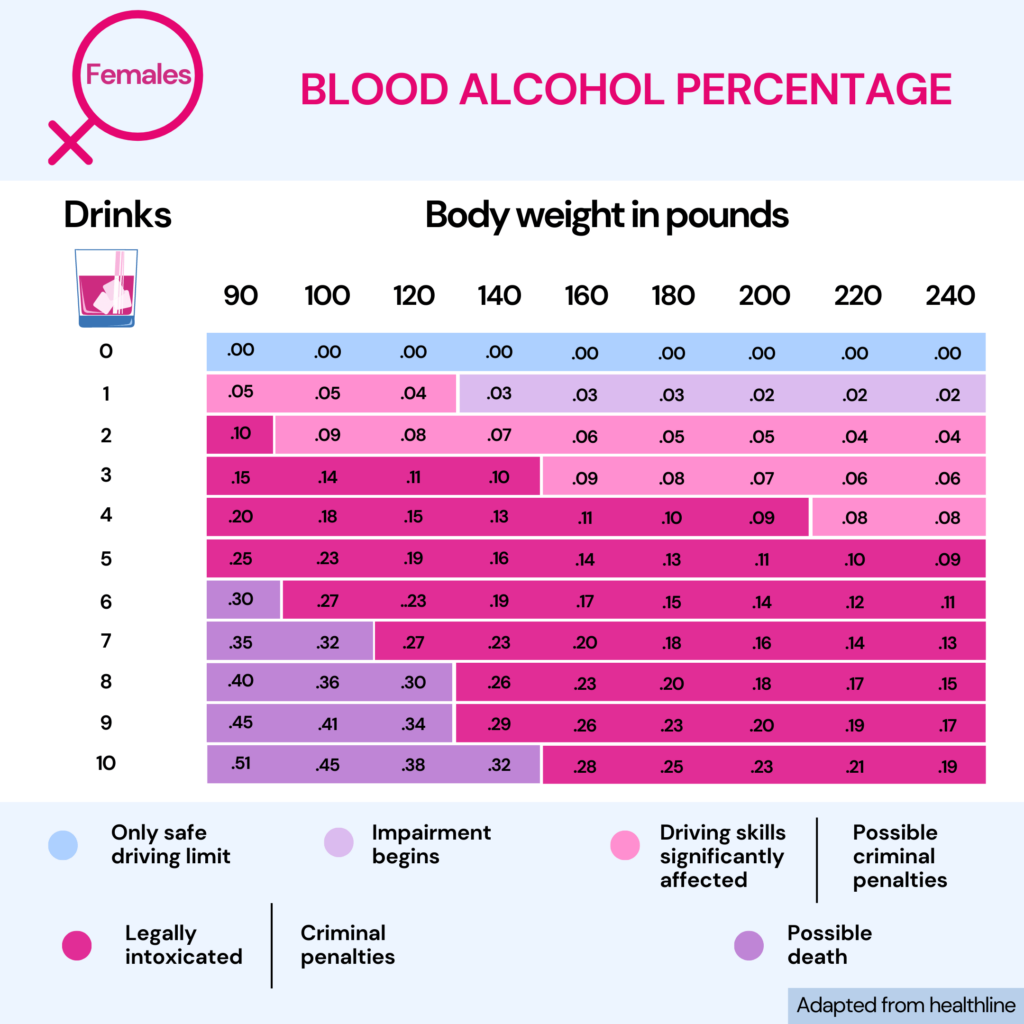
While many people may think their alcohol tolerance is good, it is not!
One of the dangers of high alcohol tolerance is binge drinking and alcoholism.
Since people with high alcohol tolerance can consume and tolerate large amounts of alcohol, they are more likely to drink more.
With increased consumption, alcohol influences changes in the brain.
For example, you are more likely to feel happy or exhilarated when you drink.
This acts as an incentive, prompting you to drink more, eventually leading to alcoholism.
Along with alcohol tolerance, other factors that may contribute to alcoholism are:
While several factors influence alcoholism, family history is one of them.
One does not inherit it in a straightforward manner.
However, you can inherit the gene changes that increase your risk of developing alcoholism can be inherited.
So, while you may not inherit the addiction itself, you may receive the genes that increase your risk of developing alcoholism.
It has also been observed that since multiple genes play a role in alcohol use disorder, it may skip a generation.
Factors that may influence alcohol tolerance are:
While there are no tests for alcohol tolerance, genetic testing at home and a medical facility are available for alcohol intolerance.
A genetic test for alcohol intolerance involves taking a blood, saliva, or tissue sample to observe changes in the ADH and ALDH genes.
Certain gene changes that lower ADH enzyme levels and increase ALDH enzyme levels can increase your alcohol tolerance.
On the other hand, gene changes resulting in high ADH and low ALDH enzyme levels can decrease your alcohol tolerance, lowering your risk for alcohol use disorders.
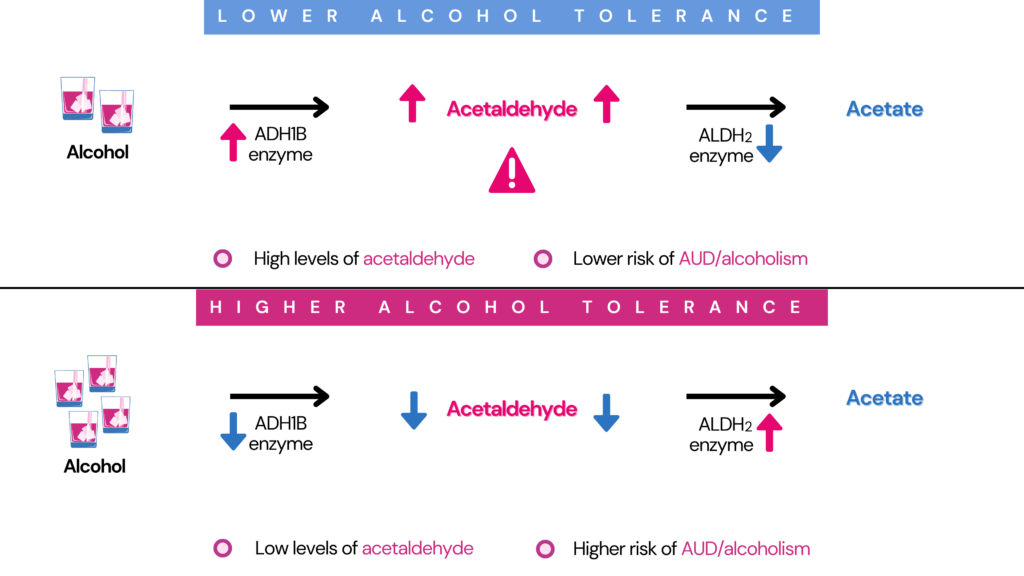
A genetic test can help reveal what changes you carry in these genes and help you understand your risk for alcohol use disorders.
When it comes to preparing for an allergy test, the list of do's and don'ts can leave you feeling perplexed.
The one question that frequently arises, especially for those who rely on their daily caffeine fix, is, “Can you enjoy a steaming cup of coffee before undergoing an allergy test?”
This article delves into the surprising relationship between coffee consumption and allergy testing, shedding light on whether that cherished cup of joe could potentially impact the results.
Your genes can affect how your body processes caffeine.
There are different versions of the caffeine genes, and depending on which one you have, you may react differently to caffeine.
This is why some people can sleep by 10 PM after drinking coffee at 7 PM, and others lay awake at 2 AM despite stopping caffeine intake by 4 PM.
Learn more about your caffeine gene:
Surprisingly, the answer is no.
Before the allergy test, it is recommended to avoid coffee and other caffeinated beverages for at least 24 to 48 hours.
Caffeine can affect test results by masking symptoms, reducing immune system responses, or causing anxiety.
However, certain guidelines may vary depending on the healthcare provider or testing facility.
For reliable and precise results, following the directions provided by the healthcare professional conducting an allergy test is essential.
There are several reasons why caffeine is discouraged before an allergy test.
Let's discuss a few among them:
Also Read: How It Works: Caffeine Genetics
While caffeine takes the spotlight, It's important to remember that avoiding caffeine alone before an allergy test is not enough. Several foods and drinks are to be avoided as well.
This list includes:
It's essential to remember that avoiding coffee before an allergy test is mainly done to ensure accurate and trustworthy results.
Now that your allergy test is over, you might wonder if you can have a cup of coffee.
Relax, there's good news! In most cases, having coffee while taking a first-generation antihistamine like Benadryl is often acceptable.
However, it's best to avoid caffeine if you're taking a second-generation antihistamine like Zyrtec or Allegra.
Still, combining caffeine with antihistamines can increase the chances of side effects like feeling jittery or having trouble sleeping.
You may continue your regular activities and eating routines, including drinking coffee. But following your healthcare expert's directions is always a good idea.
Apart from caffeine and particular food and drink restrictions, there are a few general dos and don'ts to consider when preparing for an allergy test.
These tips can help improve the test's accuracy and effectiveness:
Dos:
Don'ts:
It is usually suggested to avoid consuming caffeine or other caffeinated beverages before an allergy test. Caffeine can mask symptoms, interfere with immune system reactions, and increase anxiety, affecting the accuracy of test results.
In addition to caffeine, it is essential to avoid certain foods, vegetables, herbal supplements, antihistamines, seafood, and alcohol before an allergy test.
However, once the test ends, you can usually resume your normal activities, including drinking coffee as prescribed.
Following the guidelines provided by your healthcare expert, continuing to dietary restrictions, and addressing any concerns or questions may help ensure a successful allergy test and accurate results.
Seeking a solution for hair loss? Look no further! This article explores oral minoxidil – a revolutionary remedy that has captured the attention of those battling hair loss.
Discover how this medication can potentially restore hair growth and prevent hair loss. The article dives into the science of oral minoxidil, debunking the common misconceptions and providing you with the knowledge you need to make informed choices.
Read on to know more.
Genes can influence drug responses. Carrying certain gene changes can affect drug efficacy and put you at increased risk for side effects. Learn more:
Minoxidil is a powerful medication designed to combat the challenges of a specific form of hair loss known as pattern hair loss.
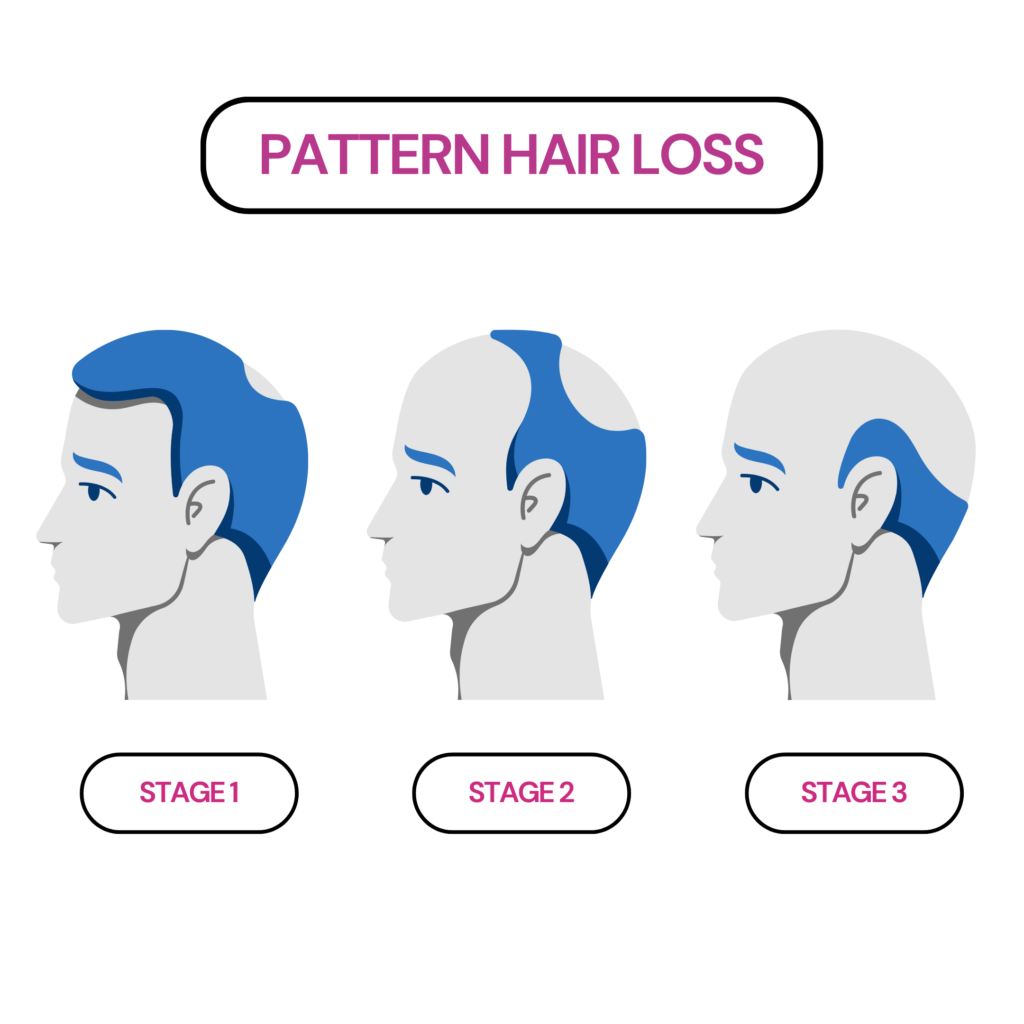
But apart from their hair loss treatment, minoxidil was originally developed to treat high blood pressure.
You can acquire minoxidil in two ways: by obtaining a prescription for the generic oral tablet or by purchasing the over-the-counter topical solution or foam (MF).
Minoxidil solution (MS) comprises water, ethanol, and propylene glycol (PG), with PG playing a crucial role in delivering the drug to the hair follicles.
Nevertheless, the presence of PG in MS may result in irritation. This prompted the researchers to develop PG-free MF as an alternative.
So, which is better? MF is advantageous compared to MS as it delivers the active ingredient with a specific region and dries faster than solutions.*
Certain versions have minoxidil in the inactive form. It is converted into the active form only upon entry into the body.
This is facilitated by an enzyme called sulfotransferase.
It converts inactive minoxidil into its active form, called minoxidil sulfate. Accordingly, patients with higher enzyme activity had greater hair growth than those with lower ones.
*Not all people respond to minoxidil the same way. Therefore, please consult your healthcare practitioner for advice on which form is better suited for your needs.
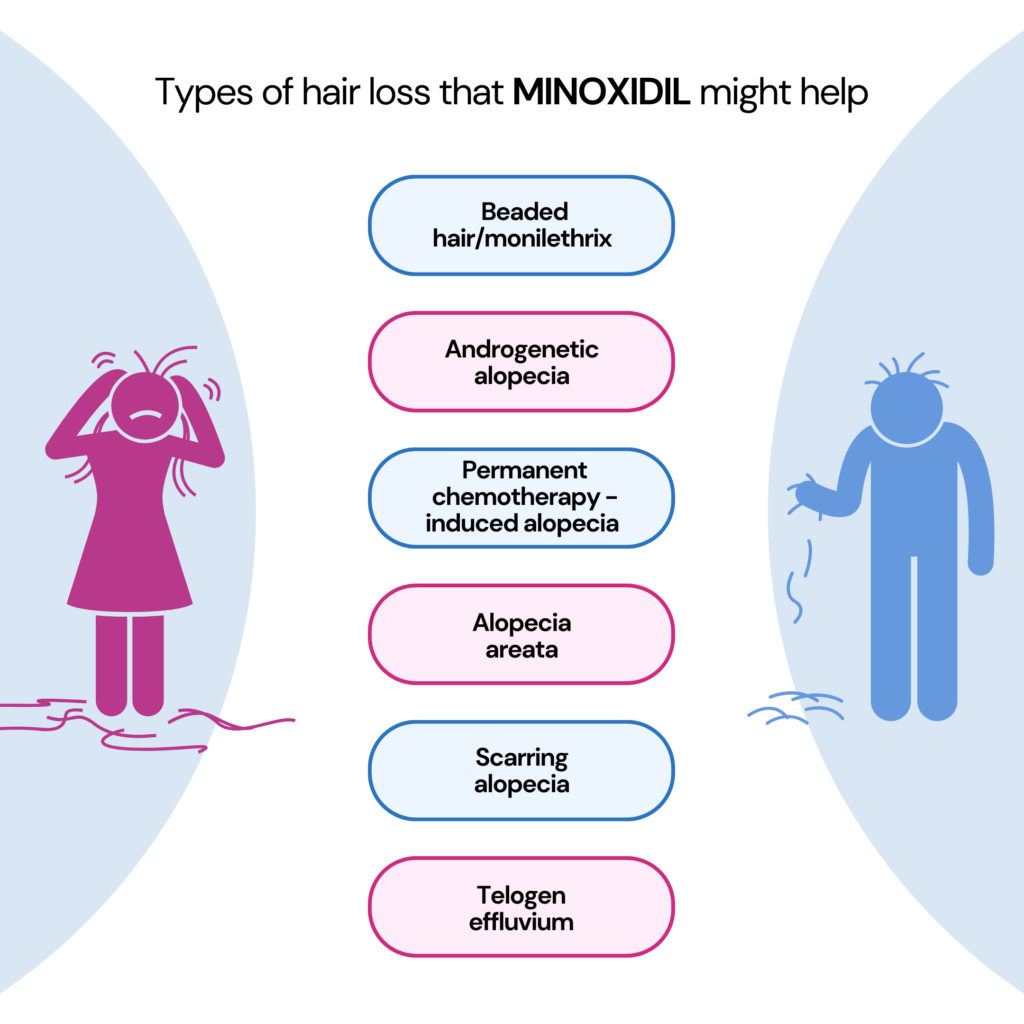
The exact mechanism behind minoxidil's effect on hair growth is unknown.
But research has indicated a potential way minoxidil fights hair loss and restores hair growth.
The hair growth cycle encompasses three distinct stages: a phase of active growth called anagen, a transition phase known as catagen that typically lasts around 10 days, and, finally, a resting phase called telogen.
Minoxidil increases the anagen phase, the growth phase of hair follicles, and the hair follicle size while reducing the resting phase.
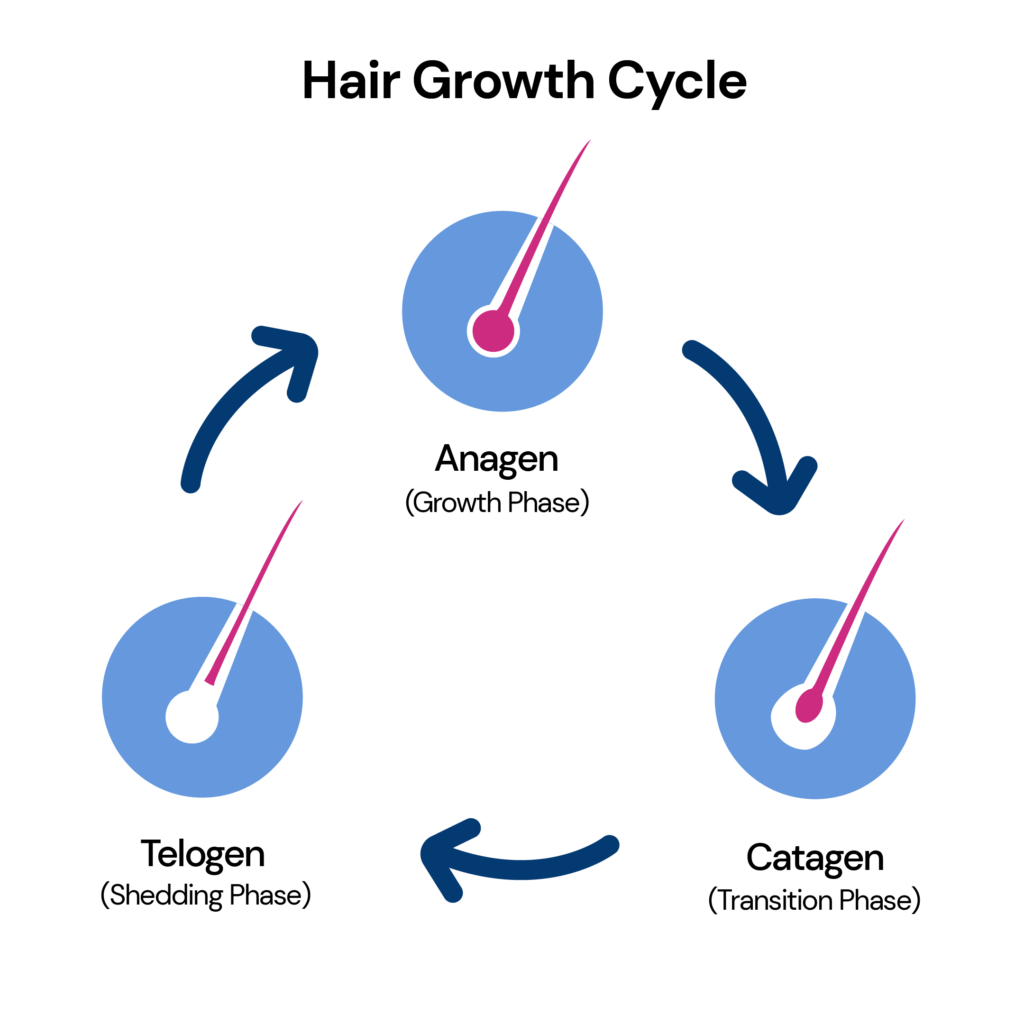
Drugs like salicylates such as acetaminophen, ibuprofen, and aspirin could lower sulfotransferase enzyme activity.
Topical minoxidil is generally safe, but some patients may experience side effects.
Performing a patch test can help identify the causative agents of the allergic reaction.
Minoxidil exerts its effects on the hair follicles, promoting hair growth and reducing hair loss. However, if you discontinue treatment, the progression of hair growth also ceases.
An initial side effect of oral minoxidil is temporary hair shedding, which typically occurs within the initial six weeks of treatment and lasts around four weeks.
It is important to persist with the medication in order to witness the potential benefits of minoxidil.
The FDA has approved topical minoxidil as an effective female pattern hair loss.
Disclaimer: Using topical minoxidil during pregnancy and breastfeeding may carry potential risks due to its association with fetal malformations. Further, usage during breastfeeding also needs to be approved by a qualified healthcare professional.
A prevalent misconception suggests that minoxidil may diminish male libido, but this claim lacks validity.
Studies report improvements in hair color, length, and coarseness with the consumption of 0.5 mg of oral minoxidil on a daily basis.
Once a person discontinues minoxidil usage, their hair growth ceases, and there is a chance of encountering hair loss comparable to the initial baldness that existed prior to using minoxidil.
Other than minoxidil, several treatment options for pattern hair loss are available. Some of them include:
As we go about our daily lives, it's not uncommon to catch ourselves engaging in a silent conversation with ourselves.
Talking to oneself is a common phenomenon, whether muttering thoughts while getting ready in the morning or reflecting on the day's events.
However, it's often misunderstood and stigmatized as a sign of mental instability.
In reality, decades of psychological research have shown that self-talk is not only normal but also plays a crucial role in our cognitive development and overall well-being.
In fact, the majority of individuals engage in self-talk in some form on a daily basis.
This article explores the reasons behind talking to oneself and the potential impact of this internal dialogue.
Genes influence many aspects of our behavior, including empathy potential, anger temperament, and self-esteem. Learn more:
Self-talk refers to the internal narration within our minds, often called the "inner voice. "
Psychologists define self-talk as verbalized thoughts directed toward oneself or some aspect of one's life.
It includes personal conversations, such as setting goals or affirmations, and reflections on daily experiences.

In the realm of human development, self-talk plays a pivotal role.
Russian psychologist Lev Vygotsky proposed in the 1930s that vocal self-talk was crucial for children's cognitive growth and emotional regulation.
Children often engage in vocal self-talk as they imitate conversations they've had with adults.
Through this process, they learn to manage their behaviors and emotions independently.
As children mature, their outward self-talk gradually transitions into internal dialogue.
This shift from vocal to internal self-talk becomes integral to their cognitive processes, allowing them to plan, problem-solve, and navigate complex situations.
Children acquire the tools to manage their behavior and emotions autonomously by rehearsing conversations and imitating adult interactions.
Inner dialogue becomes a private companion, guiding their thoughts and decision-making.

Studying self-talk poses challenges.
Since most of these talks are often spontaneous, it is difficult to rely on individuals consciously tracking them.
Thus, scientists are trying to get the basics out of the way first by answering some fundamental questions regarding self-talk:
But even with these challenges, one thing is clear: the content of our self-talk can have significant impacts on our attitude and performance.
Engaging in instructional or motivational self-talk has been shown to increase focus, boost self-esteem, and enhance task performance.
For example, athletes who incorporate instructional self-talk during practice tend to improve their concentration and accuracy.
Additionally, self-talk can help regulate emotions, reducing stress and anxiety.
Distanced self-talk, where individuals address themselves in the third person, is especially useful in dealing with emotions.

While self-talk can be a valuable tool, negative and self-critical self-talk can adversely affect our mental well-being.
People who are too tough on themselves may tend to engage in negative self-talk too often to a point where it may get toxic!
The tendency to constantly blame themselves for the problems surrounding them can result in intense feelings of depression.
Further, constant negative self-talk can indicate anxiety in both children and adults!
However, certain psychological tools can help navigate self-talk in the right direction.
Cognitive Behavioral Therapy (CBT) is an effective therapeutic approach that addresses negative self-talk and its impact on mental health.
Through CBT, individuals can gain self-awareness and recognize how their thoughts influence their emotions and behaviors.
CBT focuses on identifying and challenging negative self-talk patterns.
By examining the underlying cognitive distortions contributing to negative thinking, individuals can reframe their thoughts and replace self-criticism with self-compassion.
Therapists work with individuals to develop realistic and compassionate self-talk, fostering a positive mindset.
CBT also incorporates behavioral changes to reinforce positive self-talk.
Individuals can break free from negative cycles and build confidence by engaging in new behaviors aligned with positive thoughts.
The integration of thoughts and actions creates positive momentum in life.
It is important to note that CBT is a personalized therapy process.
Each individual's experience of self-talk and the underlying causes of negative thinking may vary.
Collaborative efforts between the individual and therapist ensure that interventions are tailored to meet specific needs.
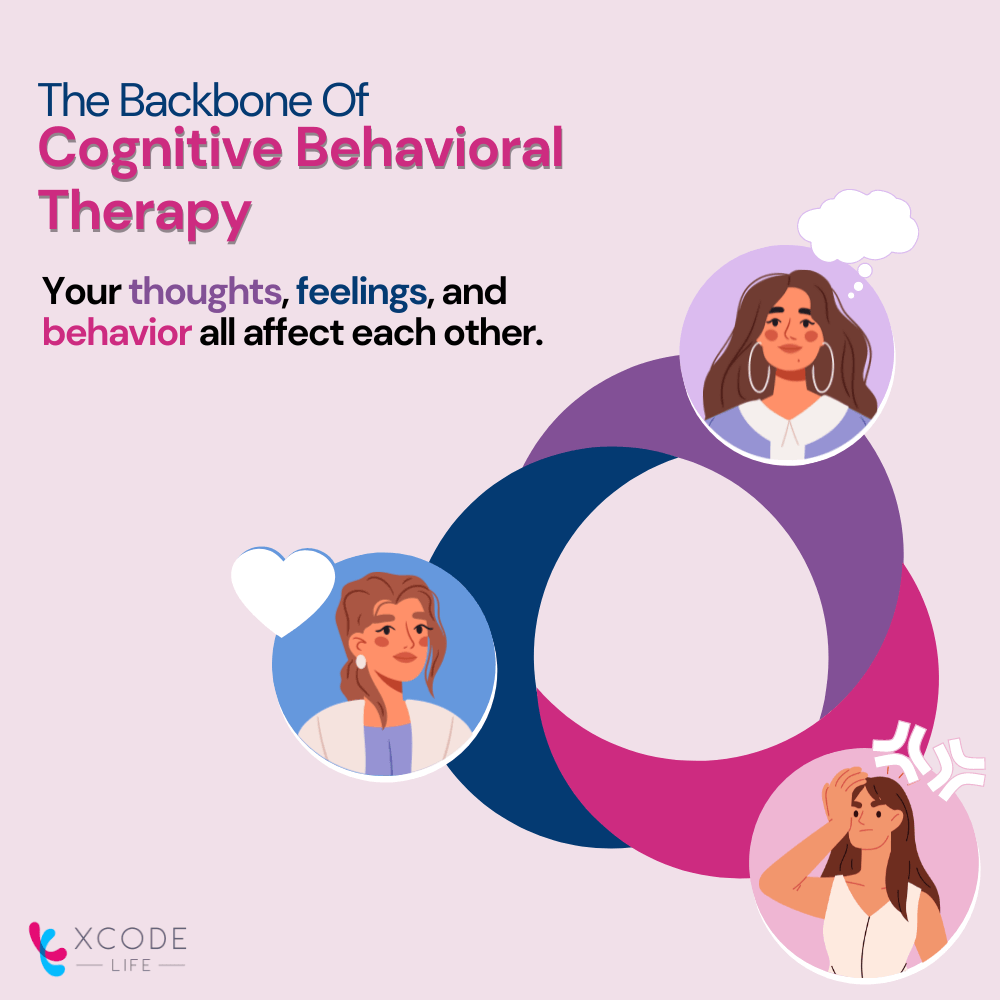
Self-talk is completely normal and common behavior.
It serves various functions throughout our lives, from childhood development to daily self-reflection and problem-solving.
The content of our self-talk significantly impacts our attitudes, performance, and emotional well-being.
Positive and instructional self-talk can increase focus, boost self-esteem, and improve task performance. However, negative self-talk, characterized by self-criticism and constant blame, can harm our mental health, leading to depression and anxiety.
Fortunately, cognitive behavioral therapy (CBT) offers effective techniques for addressing negative self-talk and promoting a positive mindset.
Individuals can reshape their self-talk patterns and enhance their overall well-being by challenging negative thoughts, fostering self-compassion, and aligning thoughts with positive actions.
So, the next time you find yourself engaged in a silent conversation with yourself, remember that it is a natural and valuable process.
Embrace the opportunity to cultivate positive self-talk, practice self-compassion, and use your inner dialogue as a supportive partner on your journey toward personal growth and well-being.